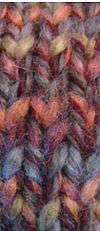Binding off
"Cast off (knitting)" redirects here. For other uses, see Cast off.
In knitting, binding off, or casting off, is a family of techniques for ending a column (a wale) of stitches. Binding off is typically used to define the final (usually upper, taking the cast on edge as the lower) edge of a knitted fabric, although it may also be used in other contexts, e.g., in making button holes. In principle, binding off is the opposite of casting on, but the techniques are generally not mirror images of one another. Sometimes, however, they can produce a mirror image appearance.
Techniques
Binding/casting off generally involves passing the final loop of a wale over the loop of an adjacent stitch. Techniques differ, however, in how this is done:
- Simple bind/cast off
- Involves simply passing each loop over an adjacent stitch. (The yarn is passed through the final loop to secure the whole chain.) This technique produces a tight edge with little elasticity. Its advantages are that
- it does not flare as many bound/cast-off edges do;
- it will retain its length, even under tension (good for shoulder seams);
- it does not require that the knitting yarn be nearby;
- it can be done in any direction.
- Knit bind/cast off
- Involves knitting each loop before passing it over the next loop. Note that you start by knitting two stitches as normal, then pull the first knitted stitch on the right needle over the second knitted stitch on the right needle, knit the next stitch on the left needle, and continue to the end. This can be done tightly or loosely, depending on the tension of the knitter. If you want to ensure that the bind/cast-off edge is loose, one method to ensure this is to use a needle at least two sizes larger than the project needle size.
- Purl bind/cast off
- Involves purling each loop before passing it over the next loop. This is simply the purl version of the knit bind/cast off. You can also do this in pattern, such as a rib pattern.
- Decrease bind/cast off
- Involves iterative decreases, e.g., "k2tog, return loop to left needle".
- Sewn bind/cast off
- This involves the use of a tapestry needle with an extremely long tail of the yarn. Using this long tail, pull the needle through two front loops as if to purl, then back through the first stitch as if to knit. Drop the first stitch off. Repeat to the end.There are several variations, but this is the most well-known.[1]
- Three needle bind/cast off
- This bind/cast off is used for joining two pieces of knitting, such as the front and back of a sweater by binding/casting off their stitches together to create a seam. For this bind/cast off, the two needles (in the case of a sweater, each may hold the shoulder stitches) are held parallel with the right sides of the knitting facing each other. Binding/casting off as with the knit bind/cast off, each stitch is the result of knitting together one stitch from each needle (i.e. pass needle through first stitch of first needle, first stitch of second needle, wrap yarn, pull through, and drop both stitches)
- Tubular bind/cast off
- A stretchy bind/cast off used on a ribbed edge; most helpful for sock and neckline edges.
References
- Hiatt, June Hemmons (1988). The Principles of Knitting. New York: Simon and Schuster. pp. 123–148.
- Reader's Digest Complete Guide to Needlework. Reader's Digest Association. 1979.
- Vogue Knitting: The Ultimate Knitting Book. New York: Sixth and Spring Books. 2002.
- Wiseman, Nancy M. (2002). The Knitter's Book of Finishing Techniques. Woodinville, WA: Martingale & Company. pp. 49–59.
- Zimmerman, Elizabeth (1971). Knitting without Tears. New York: Scribner.
- Vogue Knitting Magazine (2011). Vogue Knitting Stitchionary Volume Six: Edgings. Sixth&Spring Books. ISBN 978-1936096220.
This article is issued from Wikipedia - version of the 9/20/2016. The text is available under the Creative Commons Attribution/Share Alike but additional terms may apply for the media files.
